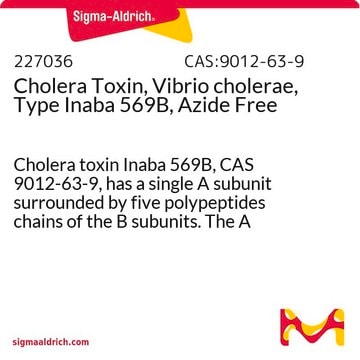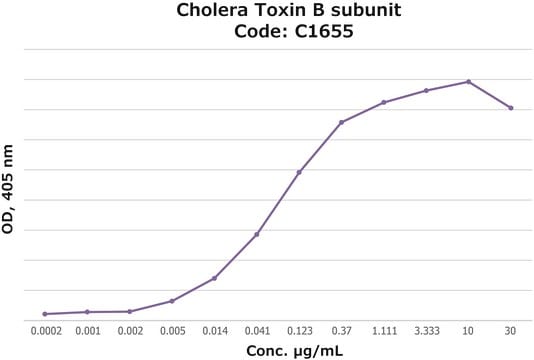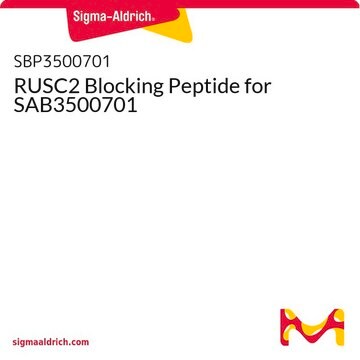The stability of this product in solution at -20C is undetermined. The recommended storage for the reconstituted solution is at 2–8 °C. Please refer to the Data Sheet for more information: https://www.sigmaaldrich.com/deepweb/assets/sigmaaldrich/product/documents/110/527/c8052dat-ms.pdf
C8052
Cholera Toxin
from Vibrio cholerae, ≥90% (SDS-PAGE), lyophilized powder, A-B type toxin
Sinónimos:
CTX, Enterotoxina del cólera, Toxina colérica
Seleccione un Tamaño
Seleccione un Tamaño
About This Item
Productos recomendados
product name
Toxina del cólera from Vibrio cholerae, ≥90% (SDS-PAGE), lyophilized powder
Quality Level
assay
≥90% (SDS-PAGE)
form
lyophilized powder
composition
Protein, ~5% Lowry-TCA
solubility
H2O: 10 mg/mL
storage temp.
2-8°C
¿Está buscando productos similares? Visita Guía de comparación de productos
General description
La toxina del cólera y su subunidad A suelen utilizarse para estudiar los mecanismos de transducción de la señal debido a su impacto en la adenilato ciclasa. Además, la toxina del cólera actúa como un adyuvante estimulando las respuestas de los linfocitos B y los linfocitos T auxiliares tipo 2 al inhibir la producción de interleucina-12. La subunidad B no tóxica (CTB) se fija a las células uniéndose al gangliósido GM1, lo que la convierte en una etiqueta útil para las células microgliales en la investigación neurológica. También se ha demostrado que es un excelente marcador para estudios de transporte axónico utilizando métodos inmunohistoquímicos.[2][3]
Application
Features and Benefits
Packaging
Physical form
Reconstitution
signalword
Danger
hcodes
Hazard Classifications
Acute Tox. 2 Dermal - Acute Tox. 2 Oral - Acute Tox. 4 Inhalation - Aquatic Chronic 3
Storage Class
6.1A - Combustible acute toxic Cat. 1 and 2 / very toxic hazardous materials
wgk_germany
WGK 3
Certificados de análisis (COA)
Busque Certificados de análisis (COA) introduciendo el número de lote del producto. Los números de lote se encuentran en la etiqueta del producto después de las palabras «Lot» o «Batch»
¿Ya tiene este producto?
Encuentre la documentación para los productos que ha comprado recientemente en la Biblioteca de documentos.
Los clientes también vieron
Artículos
Cyclic nucleotides like cAMP modulate cell function via PKA activation and ion channels.
-
Can the solution (1mg/ml) be stored at -20?
1 answer-
Helpful?
-
-
Can the lyophilized powder be stored at room temperature prior to reconstitution?
1 answer-
As listed in the Product Data Sheet, the lyophilized powder must be stored at 2–8°C. The product, as supplied, is stable for 3 years when stored properly.
Please see the Data Sheet for more information:
https://www.sigmaaldrich.com/deepweb/assets/sigmaaldrich/product/documents/110/527/c8052dat-ms.pdfHelpful?
-
-
Hey, Can this product be reconstituted to a solution and administered to mice for systemic upregulation of immune cells?
1 answer-
This product has not been tested for use in animal models, however, the preparation does contain sodium azide as a preservative. Azide is reported to have an LD50 of 19 mg/kg in mouse by I.V. route. This is not a sterile preparation, solutions would require filter sterilization prior to in vitro or in vivo use. Please see the link below to review the product datasheet:
https://www.sigmaaldrich.com/deepweb/assets/sigmaaldrich/product/documents/110/527/c8052dat-ms.pdfPlease see the following link to review a publication regarding the toxicity of azides:
https://www.tandfonline.com/doi/full/10.1080/15563650.2021.1906888#:~:text=Within%20a%20year%20of%20its,kg%20%5B14%2C15%5D.Helpful?
-
-
At what temperature and duration do I need to autoclave liquid with cholera toxin to be able to dispose of it?
1 answer-
Please refer to the SDS for disposal recommendations. Disposal methods are listed in section 6.3, including autoclaving, incineration, and chemical disinfection.
Consult with facility or municipal EHS authorities to ensure proper guidelines are followed. See the link below to review the SDS:
https://www.sigmaaldrich.com/sds/sigma/c8052See the link below to an NIH publication that may also be helpful.
https://www.ncbi.nlm.nih.gov/books/NBK218626/Helpful?
-
-
Is Product C8052, Cholera enterotoxin, cell culture tested?
1 answer-
This product is not cell culture tested.
Helpful?
-
-
Is Product C8052, Cholera enterotoxin, sterile?
1 answer-
It is not necessarily sterile, but the solution can be filter sterilized using a 0.2 micron pore size filter.
Helpful?
-
-
How is the activity of Product C8052, Cholera enterotoxin, expressed?
1 answer-
The activity is expressed in terms of units/mg of protein and not as units/mL.
Helpful?
-
-
What is the solubility and solution stability of Product C8052, Cholera enterotoxin?
1 answer-
Cholera toxin is soluble in water at a concentration of 10 mg/mL. Solutions are reported to be stable for 1 year when stored at 2-8 °C, and will lose biological activity after prolonged exposure to pH below 6 or above 8, according to Mekalanos, J.J., et al., Meth. Enzymology, 165, 169-175 (1988).
Helpful?
-
-
What is the Department of Transportation shipping information for this product?
1 answer-
Transportation information can be found in Section 14 of the product's (M)SDS.To access the shipping information for this material, use the link on the product detail page for the product.
Helpful?
-
-
What is the molecular weight Product C8052, Cholera enterotoxin?
1 answer-
Although the molecular weight is not part of our specifications for this product, it has been reported to be 84 kDa in Biochimica Biophysica Acta, 492, 303 (1977).
Helpful?
-
Active Filters
Nuestro equipo de científicos tiene experiencia en todas las áreas de investigación: Ciencias de la vida, Ciencia de los materiales, Síntesis química, Cromatografía, Analítica y muchas otras.
Póngase en contacto con el Servicio técnico










